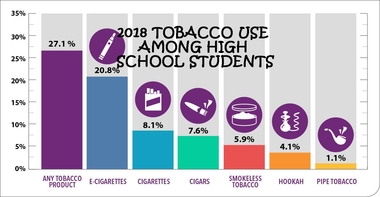Progress erased: Youth tobacco use increased during 2017-2018

About 4.9 million middle and high school students were current users, or have used in the past 30 days, of some type of tobacco product in 2018. This number has significantly increased from 3.6 million in 2017.
This increase, driven by a surge in e-cigarette use, erased past progress in reducing youth tobacco product use, according to a new report published by the Centers for Disease Control and Prevention (CDC).
Except for e-cigarettes, no change was found in the use of other tobacco products, including cigarettes, resulting in a net increase in overall tobacco product use during 2017-2018. There were 1.5 million more youth e-cigarette users in 2018 than 2017, and those who were using e-cigarettes were using them more often, as was previously reported in November 2018.
Frequent use (more than 20 days in the past 30 days) of e-cigarettes, increased from 20 percent in 2017 to 28 percent in 2018 among current high school e-cigarette users.
More than 1 in 4 (27.1 percent) high school students and about 1 in 14 (7.2 percent) middle school students currently used a tobacco product in 2018.
For the fifth year in a row, e-cigarettes (20.8 percent) were the most commonly used tobacco product among high schoolers, followed by cigarettes (8.1 percent), cigars (7.6 percent), smokeless tobacco (5.9 percent), hookah (4.1 percent), and pipe tobacco (1.1 percent). Among middle schoolers, e-cigarettes (4.9 percent) were also the most commonly used tobacco product, followed by cigarettes (1.8 percent), smokeless tobacco (1.8 percent), cigars (1.6 percent), hookah (1.2 percent), and pipe tobacco (0.3 percent).
Many youth tobacco product users are also using multiple products. Among current tobacco users, about 2 in 5 (1.68 million) high school students and 1 in 3 (270,000) middle school students used two or more tobacco products in 2018. The most commonly used tobacco product combination was e-cigarettes and conventional cigarettes among both middle and high school students.
“The skyrocketing growth of young people’s e-cigarette use over the past year threatens to erase the progress made in reducing youth tobacco use,” said Robert Redfield, M.D., CDC Director. “It’s putting a new generation at risk for nicotine addiction. We must continue to use proven strategies to protect America’s youth from this preventable health risk.”
Youth use of any tobacco product, including e-cigarettes, is unsafe.
“These data are a sobering reminder of the rampant rise of youth e-cigarette use. I fear this trend will continue in 2019, forcing us to make some tough decisions about the regulatory status of e-cigarettes,” said FDA Commissioner Scott Gottlieb, M.D. “No child should be using any tobacco or nicotine-containing product, and we’re committed to reversing this epidemic.”
Why are these findings a significant public health concern?
Tobacco use is the leading cause of preventable disease and death in the United States, and nearly all tobacco use begins in adolescence.
Cigarette smoke contains more than 7,000 chemicals, about 70 of which can cause cancer.
Nearly all tobacco products, including e-cigarettes, contain nicotine.
The U.S. Surgeon General has concluded that nicotine exposure during adolescence can harm the developing brain—which continues to develop until about age 25.
Nicotine exposure during adolescence impacts learning, memory, and attention and primes the brain for addiction.
Symptoms of nicotine addiction are increased in multiple tobacco product users compared with single-product users.
Youth who use e-cigarettes may be more likely to go on to smoke conventional cigarettes.
More can be done like regulating the manufacture, distribution, and marketing of tobacco products, coupled with proven population-based strategies, can reduce youth tobacco use and initiation.
We must increase prices of tobacco products, protect people from exposure to secondhand smoke and e-cigarette aerosol, staining hard-hitting media campaigns that warn about the dangers of tobacco product use.
And we must restrict youth access to tobacco products, including increasing the minimum age of sale of tobacco products to 21 years and prohibiting the sale of flavored tobacco products.
To read the entire report, visit www.cdc.gov/vitalsigns, or learn more about preventing young people from using tobacco products, visit www.BeTobaccoFree.gov.
The Gayly. 3/6/2019 @ 7:41 a.m. CST.





